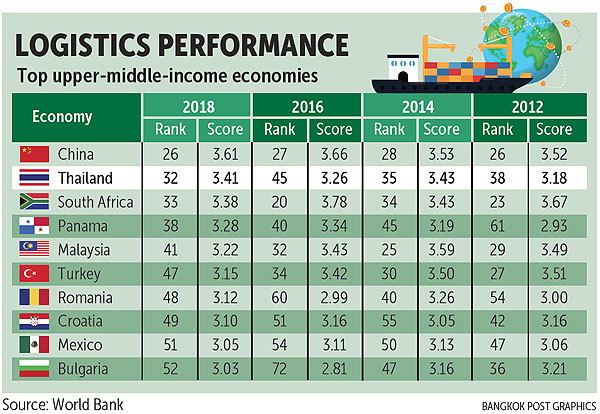Thailand surges 13 spots in World Bank logistics index
Thailand’s logistics performance has greatly improved this year, thanks to massive investment in transport infrastructure and relevant legal reforms.
According to the World Bank’s Logistics Performance Index 2018, Thailand rose to 32nd this year from 45th in 2016.
Thailand’s ranking was second only to Singapore in Asean, overtaking Malaysia, and was seventh in Asia.
Thailand scored 3.41 out of 5, up from 3.26 in 2016.
Kobsak Pootrakul, the Prime Minister’s Office Minister, said the biennial index measures customs procedures; infrastructure development such as ports, railways, highways and related technology; international shipments; logistics competence; tracking and tracing; and timeliness.
Mr Kobsak said Thailand’s rise in the logistics index reflects the government’s commitment to investing in infrastructure and reforming regulations and laws.
“The government is quite upbeat that the index will significantly improve over the next two years because the government has already invested heavily in infrastructure development and law reforms,” he said.
According to the World Bank, the index is an interactive benchmarking tool created to help countries identify the challenges and opportunities they face in trade logistics and what they can do to improve their performance.
The index for 2018 compared 160 countries. A worldwide survey of operators on the ground (global freight forwarders and express carriers) provided feedback on the logistics “friendliness” of the countries in which they operate and those with which they trade.
Feedback from operators was supplemented with quantitative data in the performance of key components of the logistics chain in the country of work.
The index therefore consists of both qualitative and quantitative measures and helps build profiles of logistics friendliness for these countries.
It measures performance along the logistics supply chain within a country and offers two different perspectives: international and domestic.
Thailand has extensively invested in transport infrastructure under the 12th National Economic and Social Development Plan, which aims to cut the country’s logistics costs to 12% of GDP by 2021 from 14% in 2016, when the 11th plan (2012-16) ended.
The 12th plan (2017-2021) will call not only for transport infrastructure development in major cities and border towns, but also improved connectivity with neighbouring countries.
The new plan aims to raise the rail transport load to 4% of total transport from 1.4% and goods transported through waterways to 15% from 12%, while reducing road transport load to 80% of total transport in 2021 from the existing 88%.
The plan also aims to provide internet access to 85% of the country’s villages nationwide, up from 30% in the previous plan.
Rail development will be instrumental in reducing logistics costs.
The double-track rail network currently accounts for just 8-9% of total rail transport.
The 12th plan calls for the development of 14 double-track rail projects, which will increase the double-track rail network’s coverage to 2,500km by 2021, up from only 359km now.
Source: https://www.bangkokpost.com/business/news/1514830/thailand-surges-13-spots-in-world-bank-logistics-index


 English
English




